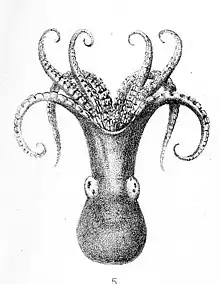| Octopus superciliosus | |
|---|---|
 | |
| Scientific classification | |
| Domain: | Eukaryota |
| Kingdom: | Animalia |
| Phylum: | Mollusca |
| Class: | Cephalopoda |
| Order: | Octopoda |
| Family: | Octopodidae |
| Genus: | Octopus |
| Species: | O. superciliosus |
| Binomial name | |
| Octopus superciliosus | |
Octopus superciliosus (commonly the frilled pygmy octopus)[1] is a species of octopus.[2] It was first described in 1832 by Jean René Constant Quoy and Joseph Paul Gaimard[3] based on a specimen found off Victoria during the 1826 to 1829 voyage of the Astrolabe.[4]
Description
O. superciliosus is described as a pygmy species.[5] It is small, with a mantle length of up to 26 millimeters and a total length of up to 94 millimeters. It is white and cream to light brown, with an egg-shaped mantle and large eyes.[4]
Distribution
O. superciliosus is found in southeastern Australia, ranging from the central Great Australian Bight to Twofold Bay in New South Wales.[6] It in an inshore species,[4] with recorded depths from zero to 69 meters.[5] O. superciliosus lives in sandy or mud bottoms, or among sponges or polyzoans.[4]
Life cycle
Female O. superciliosus lay large eggs, around 8-11 millimeters in length.[4] Clutch sizes are unknown, but estimated at 50 to 100 eggs. Hatchlings are benthic and 4 to 5 millimeters in length.[6]
References
- ↑ Finn, J.; Norman, M. (2014). "Octopus superciliosus Quoy & Gaimard, 1832, Frilled Pygmy Octopus". Museums Victoria Collections. Retrieved 2023-02-01.
- ↑ "Species: Octopus superciliosus (Frilled Pygmy Octopus)". Atlas of Living Australia. Retrieved 2023-02-01.
- ↑ Lu, C. C.; Scheltema, A. M.; Gowlett-Holmes, K. (2001). Mollusca: Aplacophora, Polyplacophora, Scaphopoda, Cephalopoda. Zoological Catalogue of Australia. Vol. 17. Collingwood, Victoria: CSIRO Publishing. p. 164. ISBN 978-0-643-06707-3.
- 1 2 3 4 5 Stranks, Timothy N. (1998). "The Systematic and Nomenclatural Status of the Octopodinae Described from Australia (Mollusca: Cephalopoda)". In Voss, Nancy A.; Vecchione, Michael; Toll, Roland B.; Sweeney, Michael J. (eds.). Systematics and Biogeography of Cephalopods Volume II (PDF). Smithsonian Contributions to Zoology. Vol. 586. Washington, DC: Smithsonian Institution Press. pp. 277–599. doi:10.5479/si.00810282.586.277.
- 1 2 Norman, M. D.; Finn, J. K. (2016). "Family Octopodidae". In Jereb, Patrizia; Roper, Clyde F. E.; Norman, Mark D.; Finn, Julian K. (eds.). Cephalopods of the World: An Annotated and Illustrated Catalogue of Cephalopod Species Known to Date. FAO Species Catalogue for Fishery Purposes. Vol. 3: Octopods and Vampire Squids. Rome, Italy: Food and Agriculture Organization of the United Nations. ISBN 978-92-5-107989-8.
- 1 2 Stranks, Timothy N. (1996). "Biogeography of Octopus species (Cephalopoda: Octopodidae) from southeastern Australia" (PDF). American Malacological Bulletin. 12 (1/2): 145–151.